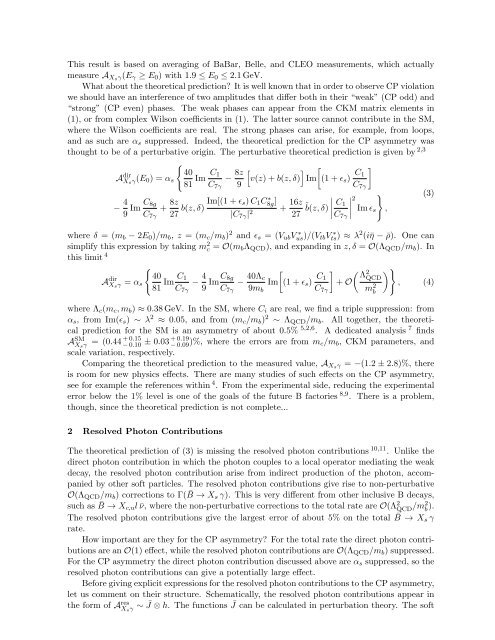2011 QCD and High Energy Interactions - Rencontres de Moriond ...
2011 QCD and High Energy Interactions - Rencontres de Moriond ...
2011 QCD and High Energy Interactions - Rencontres de Moriond ...
Create successful ePaper yourself
Turn your PDF publications into a flip-book with our unique Google optimized e-Paper software.
This result is based on averaging of BaBar, Belle, <strong>and</strong> CLEO measurements, which actually<br />
measure AXsγ(Eγ ≥ E0) with 1.9 ≤ E0 ≤ 2.1 GeV.<br />
What about the theoretical prediction? It is well known that in or<strong>de</strong>r to observe CP violation<br />
we should have an interference of two amplitu<strong>de</strong>s that differ both in their “weak” (CP odd) <strong>and</strong><br />
“strong” (CP even) phases. The weak phases can appear from the CKM matrix elements in<br />
(1), or from complex Wilson coefficients in (1). The latter source cannot contribute in the SM,<br />
where the Wilson coefficients are real. The strong phases can arise, for example, from loops,<br />
<strong>and</strong> as such are αs suppressed. In<strong>de</strong>ed, the theoretical prediction for the CP asymmetry was<br />
thought to be of a perturbative origin. The perturbative theoretical prediction is given by 2,3<br />
A dir<br />
Xsγ(E0) = αs<br />
− 4 C8g<br />
Im<br />
9 C7γ<br />
<br />
40 C1<br />
Im<br />
81 C7γ<br />
− 8z<br />
9<br />
+ 8z<br />
27 b(z, δ) Im[(1 + ɛs) C1C ∗ 8g ]<br />
|C7γ| 2 + 16z<br />
<br />
<br />
v(z) + b(z, δ) Im (1 + ɛs) C1<br />
<br />
C7γ<br />
27 ˜ <br />
<br />
b(z, δ) <br />
<br />
C1<br />
C7γ<br />
<br />
<br />
<br />
<br />
2<br />
Im ɛs<br />
where δ = (mb − 2E0)/mb, z = (mc/mb) 2 <strong>and</strong> ɛs = (VubV ∗ us)/(VtbV ∗<br />
ts) ≈ λ 2 (i¯η − ¯ρ). One can<br />
simplify this expression by taking m 2 c = O(mbΛ<strong>QCD</strong>), <strong>and</strong> exp<strong>and</strong>ing in z, δ = O(Λ<strong>QCD</strong>/mb). In<br />
this limit 4<br />
A dir<br />
Xsγ = αs<br />
<br />
40 C1<br />
Im<br />
81 C7γ<br />
− 4 C8g<br />
Im<br />
9 C7γ<br />
− 40Λc<br />
9mb<br />
<br />
<br />
Im (1 + ɛs) C1<br />
<br />
Λ2 <strong>QCD</strong><br />
+ O<br />
C7γ<br />
m 2 b<br />
,<br />
<br />
(3)<br />
, (4)<br />
where Λc(mc, mb) ≈ 0.38 GeV. In the SM, where Ci are real, we find a triple suppression: from<br />
αs, from Im(ɛs) ∼ λ 2 ≈ 0.05, <strong>and</strong> from (mc/mb) 2 ∼ Λ<strong>QCD</strong>/mb. All together, the theoreti-<br />
cal prediction for the SM is an asymmetry of about 0.5% 5,2,6 . A <strong>de</strong>dicated analysis 7 finds<br />
ASM + 0.15 + 0.19<br />
Xsγ = (0.44 − 0.10 ± 0.03 − 0.09 )%, where the errors are from mc/mb, CKM parameters, <strong>and</strong><br />
scale variation, respectively.<br />
Comparing the theoretical prediction to the measured value, AXsγ = −(1.2 ± 2.8)%, there<br />
is room for new physics effects. There are many studies of such effects on the CP asymmetry,<br />
see for example the references within 4 . From the experimental si<strong>de</strong>, reducing the experimental<br />
error below the 1% level is one of the goals of the future B factories 8,9 . There is a problem,<br />
though, since the theoretical prediction is not complete...<br />
2 Resolved Photon Contributions<br />
The theoretical prediction of (3) is missing the resolved photon contributions 10,11 . Unlike the<br />
direct photon contribution in which the photon couples to a local operator mediating the weak<br />
<strong>de</strong>cay, the resolved photon contribution arise from indirect production of the photon, accompanied<br />
by other soft particles. The resolved photon contributions give rise to non-perturbative<br />
O(Λ<strong>QCD</strong>/mb) corrections to Γ( ¯ B → Xs γ). This is very different from other inclusive B <strong>de</strong>cays,<br />
such as ¯ B → Xc,ul ¯ν, where the non-perturbative corrections to the total rate are O(Λ 2 <strong>QCD</strong> /m2 b ).<br />
The resolved photon contributions give the largest error of about 5% on the total ¯ B → Xs γ<br />
rate.<br />
How important are they for the CP asymmetry? For the total rate the direct photon contributions<br />
are an O(1) effect, while the resolved photon contributions are O(Λ<strong>QCD</strong>/mb) suppressed.<br />
For the CP asymmetry the direct photon contribution discussed above are αs suppressed, so the<br />
resolved photon contributions can give a potentially large effect.<br />
Before giving explicit expressions for the resolved photon contributions to the CP asymmetry,<br />
let us comment on their structure. Schematically, the resolved photon contributions appear in<br />
the form of A res<br />
Xsγ ∼ ¯ J ⊗ h. The functions ¯ J can be calculated in perturbation theory. The soft








![List of participants 27/2/09 [pdf] - Rencontres de Moriond - IN2P3](https://img.yumpu.com/17975746/1/190x135/list-of-participants-27-2-09-pdf-rencontres-de-moriond-in2p3.jpg?quality=85)







